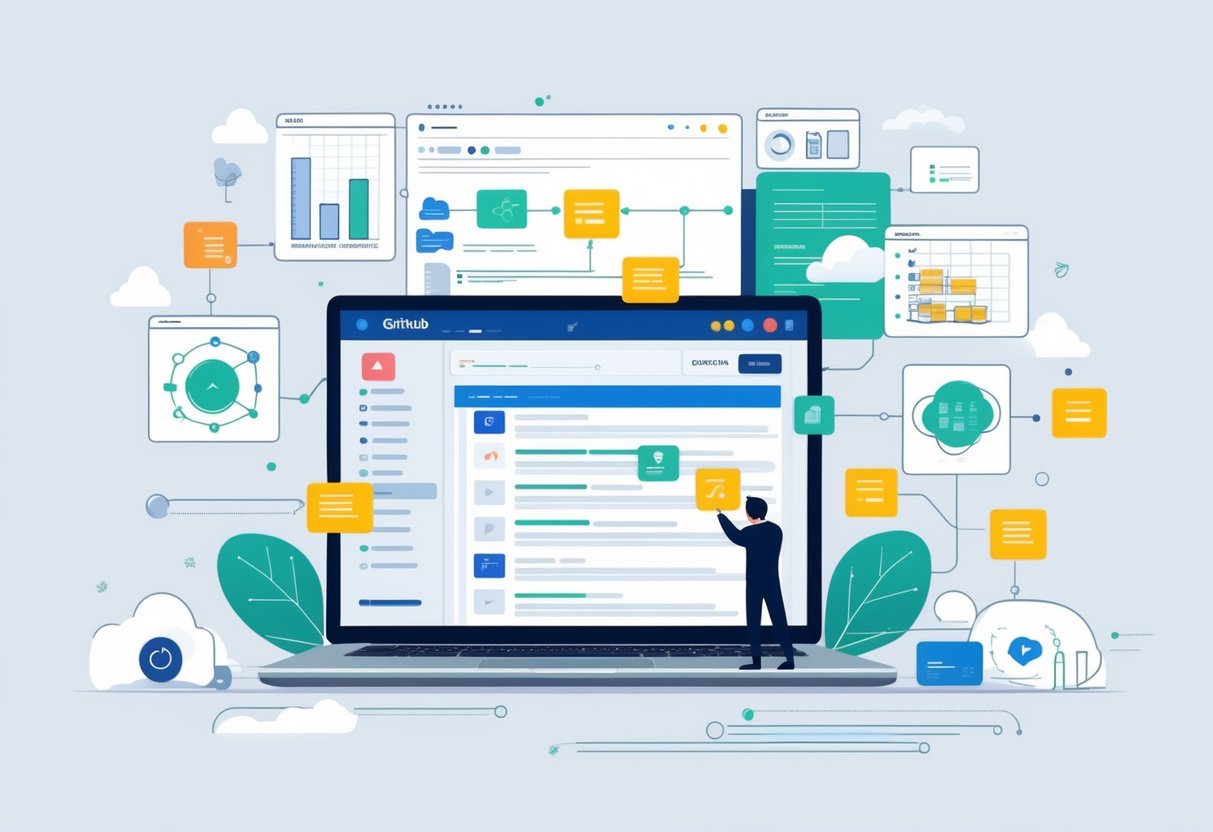Data scientists and analysts need a reliable way to store, track, and share their projects with others. Setting up a GitHub repository provides version control, collaboration tools, and professional project management capabilities.
These features make data work more organized and accessible.

GitHub repositories serve as digital folders that track every change made to data files, code, and documentation. They allow data professionals to work with team members, showcase their skills to employers, and maintain a backup of important work.
The platform also makes it easy to share findings and get feedback from the data community.
This guide walks through the complete process of creating a repository for data projects, from initial setup to sharing work with others. Readers will learn how to organize files properly and set up collaboration features.
Key Takeaways
- GitHub repositories provide version control and backup protection for data science projects
- Proper file organization and documentation make data projects easier to understand and share
- Collaboration features allow teams to work together and share findings with the broader community
Preparing for Your GitHub Repository

Setting up a GitHub repository requires three essential steps. These are creating a GitHub account, installing Git software, and configuring your Git settings.
Creating a GitHub Account
A GitHub account serves as your identity on the platform and provides access to all repository features. Users can create their first GitHub account by visiting GitHub.com and clicking the “Sign up” button.
The registration process requires three key pieces of information:
- Username: Choose a professional name that represents your work
- Email address: Use an email you check regularly for notifications
- Password: Create a strong password with letters, numbers, and symbols
GitHub offers both free and paid plans. The free plan includes unlimited public repositories and limited private repositories.
After creating the account, users should verify their email address. GitHub sends a confirmation email that must be clicked to activate full account features.
Installing Git on Your Local Machine
Git installation varies depending on the operating system being used. The software enables version control and connects local projects to GitHub repositories.
Windows users can download Git from git-scm.com and run the installer. The installation wizard includes several options, but beginners can safely use the default settings.
Mac users have two installation options:
- Download from git-scm.com
- Install through Homebrew using
brew install git
Linux users can install Git through their package manager:
- Ubuntu/Debian:
sudo apt-get install git - CentOS/RedHat:
sudo yum install git
Users can verify successful installation by opening their terminal or command prompt and typing git --version. This command displays the installed Git version number.
Configuring Git Settings
Git configuration connects local work to the GitHub account and ensures proper attribution of commits. Two essential settings must be configured before creating the first repository.
The first setting establishes the user’s name:
git config --global user.name "Your Full Name"
The second setting links the GitHub email address:
git config --global user.email "your.email@example.com"
These commands use the --global flag, which applies settings to all repositories on the computer. Users can verify their configuration by running git config --list to display all current settings.
Additional useful configurations include setting the default text editor and enabling colored output for better readability in the terminal.
Creating and Initializing a New Repository

Setting up a GitHub repository involves creating the project space online. Select the right privacy settings, add essential files like README and .gitignore, then download the repository to work on locally.
Starting a New Repository on GitHub
Users begin by logging into their GitHub account and clicking the green “New” button or the plus icon in the top-right corner. The repository creation page appears with several required fields.
The repository name should be descriptive and use lowercase letters with hyphens instead of spaces. Data project names like “sales-analysis-2025” or “customer-segmentation-study” work well.
Users must add a brief description explaining the project’s purpose. This helps others understand what the repository contains at a glance.
Repository Settings:
- Name: Use descriptive, lowercase names with hyphens
- Description: Brief explanation of the project purpose
- Visibility: Public or private access
- Initialize: Add README, .gitignore, and license files
The owner field shows the account or organization that will own the repository. Personal accounts and organization accounts both appear in this dropdown menu.
Choosing Repository Visibility
GitHub offers two main visibility options for repositories. Public repositories allow anyone on the internet to view the code, files, and commit history.
Private repositories restrict access to the owner and invited collaborators only.
Data projects often contain sensitive information like customer data, API keys, or proprietary algorithms. These projects should use private visibility to protect confidential information.
Public repositories work well for educational projects, open-source tools, or portfolio demonstrations.
Visibility Comparison:
| Feature | Public | Private |
|---|---|---|
| Who can view | Anyone | Owner + collaborators |
| Search visibility | Yes | No |
| GitHub Pages | Free | Paid plans only |
| Best for | Portfolio, open source | Business, sensitive data |
Repository visibility can be changed later in the settings. Switching from private to public requires careful review of all files and commit history.
Adding a README and .gitignore
The README file serves as the project’s front page and first impression. GitHub automatically displays README.md content on the repository homepage.
A good README includes the project title, description, installation instructions, and usage examples. Data projects should explain the dataset source, analysis methods, and key findings.
The .gitignore file tells Git which files to ignore and never track. This prevents sensitive files like API keys, large datasets, or temporary files from being uploaded to GitHub.
Common .gitignore entries for data projects:
*.csv– Large data filesconfig.py– Configuration files with secrets__pycache__/– Python cache directories.env– Environment variables*.log– Log files
GitHub provides template .gitignore files for different programming languages. The Python template includes common patterns for data science projects using pandas, jupyter, and scikit-learn.
License files define how others can use the project code. MIT and Apache 2.0 licenses allow broad usage, while proprietary projects may skip licensing entirely.
Cloning the Repository Locally
After creating the repository on GitHub, users need to download it to their local computer for development work. This process is called cloning and creates a complete copy of the repository.
The green “Code” button on the repository page shows the clone URL. Users can choose between HTTPS and SSH protocols for authentication.
Git initialization commands help set up the local working environment. Users open their terminal or command prompt and navigate to their desired project folder.
The clone command downloads all repository files and git history:
git clone https://github.com/username/repository-name.git
This creates a new folder with the repository name containing all project files. The local repository automatically connects to the GitHub remote repository for future updates.
Users can verify the connection using git remote -v which displays the remote repository URLs. The output shows “origin” pointing to the GitHub repository for both fetch and push operations.
Organizing and Managing Data Projects in GitHub

Data projects need clear folder structures and version control to stay organized. Setting up proper branches and writing clear commit messages helps track changes and collaborate with others.
Structuring Folders and Files for Data Projects
A well-organized repository makes data projects easier to navigate and maintain.
The root directory should contain these essential folders:
- data/ – Raw datasets and processed files
- notebooks/ – Jupyter notebooks and analysis files
- scripts/ – Python, R, or other code files
- docs/ – Documentation and reports
- results/ – Output files, charts, and final products
The data folder needs subfolders for different stages. Create raw/ for original datasets that never get changed.
Add processed/ for cleaned data ready for analysis. Include external/ for data from outside sources.
Code files should go in logical groups. Put data cleaning scripts in one folder and keep analysis scripts separate from visualization code.
A README.md file in each major folder explains what it contains. This helps team members understand the project structure quickly.
Using Branches for Project Versions
Branches let data scientists work on different parts of a project without breaking the main code. The main branch should always contain working, tested code.
Create feature branches for specific tasks. Name them clearly like data-cleaning or model-training.
Start new branches from the main branch to get the latest code. Work on one task per branch to keep changes focused.
Switch between branches to work on different parts of the project. Test code thoroughly before merging back to main.
Delete old branches after merging to keep the repository clean.
Use branches for experiments too. Create experiment-neural-network or test-new-algorithm branches.
Committing Changes with Meaningful Messages
Good commit messages help track what changed and why. Write messages that explain the purpose of each change in simple terms.
Start commit messages with action words like “Add,” “Fix,” or “Update.” Be specific about what the commit does.
Make commits for logical chunks of work. Commit after cleaning a dataset or fixing a bug.
Keep commit messages under 50 characters for the first line. Add more details in the body if needed.
Include file types in messages when helpful. Write “Update Python script for model training” or “Fix error in R analysis notebook.”
Collaborating and Sharing Your Data Repository

Data projects become more valuable when shared with the right people and developed collaboratively. GitHub provides built-in tools for managing team access and coordinating changes through structured workflows.
Setting Up Collaborators and Permissions
Repository owners can add team members through the Settings tab in their GitHub repository. Click on “Manage access” to invite collaborators by their GitHub username or email address.
GitHub offers three permission levels for repositories:
| Permission Level | Access Rights |
|---|---|
| Read | View and clone repository |
| Write | Push changes and manage issues |
| Admin | Full repository control including settings |
For data projects, assign Write access to team members who will contribute datasets or analysis code. Reserve Admin access for project leads who need to manage repository settings and security.
Private repositories require explicit invitations for each collaborator. Public repositories allow anyone to view the code but still require permission for direct contributions.
Teams working with sensitive data should use private repositories initially. They can make repositories public later after removing any confidential information.
Publishing Your Project
Making a data repository public increases its impact and allows others to build on the work.
Before publishing, ensure all sensitive data has been removed or properly anonymized.
Add a clear README file that explains the project purpose, data sources, and how to reproduce results.
Include information about data formats, software requirements, and any preprocessing steps needed.
Creating your first repository involves choosing between public and private visibility during setup.
This choice can be changed later in repository settings.
Consider adding topics and tags to help others discover the repository.
Use relevant keywords like “data-analysis,” “machine-learning,” or specific domain terms.
A well-organized repository structure makes it easier for others to understand and use the project.
Include folders for raw data, processed data, scripts, and documentation.
Using Issues and Pull Requests
Issues help track bugs, feature requests, and discussion points in data projects.
Create issues to document data quality problems, request new datasets, or suggest analysis improvements.
GitHub’s issue templates can standardize how team members report problems.
Create templates for bug reports, data requests, and feature suggestions to ensure consistent information collection.
Pull requests enable controlled collaboration on data projects.
When working on data projects, create separate branches for different analysis approaches or dataset versions.
This allows team members to experiment without affecting the main project.
Review pull requests carefully before merging, especially changes to data processing scripts or analysis code.
Data projects require extra attention to maintain reproducibility and accuracy.
Frequently Asked Questions
Setting up GitHub repositories for data projects involves specific commands and workflows.
These common questions cover repository initialization, file uploads, and project organization methods.
How do I initialize a new git repository for a data project?
Users can initialize a new git repository by opening their terminal or command prompt in the project folder.
They run the command git init to create a new local repository.
This command creates a hidden .git folder that tracks all changes.
The repository starts empty and ready for files.
Data scientists should add a .gitignore file early to exclude large datasets and temporary files.
This prevents accidentally uploading huge files to GitHub.
What are the steps for creating a GitHub repository from the command line?
Developers need the GitHub CLI tool installed on their computer first.
They run gh auth login to connect their GitHub account.
The command gh repo create repository-name creates a new repository on GitHub.
Users can add flags like --public or --private to set visibility.
After creation, they link their local folder with git remote add origin repository-url.
This connects the local and remote repositories together.
Can you create a GitHub repository directly from VSCode, and if so, how?
VSCode users can create repositories through the Source Control panel.
They click the “Publish to GitHub” button when working on an untracked project.
The editor shows a dialog box asking for repository name and privacy settings.
Users choose their options and click publish.
VSCode automatically handles the git initialization and first commit.
This method works well for beginners who prefer visual interfaces over command lines.
What is the process to push an existing local project to a new GitHub repository?
Users first create a repository on GitHub through the web interface.
They should not initialize it with README, license, or gitignore files.
In their local project folder, they run git init if not already done.
Then they add files with git add . and commit with git commit -m "first commit".
They connect to GitHub with git remote add origin repository-url.
Finally, they push with git push -u origin main to upload all files.
How can I upload files to my GitHub repository?
The web interface allows drag-and-drop file uploads directly to repositories.
Users navigate to their repository page and click “Add file” then “Upload files”.
Command line users run git add filename for specific files or git add . for all changes.
They commit with git commit -m "message" and push with git push.
Large data files need special handling through Git LFS (Large File Storage).
Regular git repositories have file size limits that data projects often exceed.
What are some best practices for structuring data projects in GitHub repositories?
Data projects should separate code, data, and documentation into clear folders. Common structure includes /data, /src, /notebooks, and /docs directories.
The README file should explain the project purpose and setup instructions. It should also describe the data sources.
A proper .gitignore file excludes large datasets, temporary files, and environment configurations. Data scientists often store raw data elsewhere and include download scripts instead.
Requirements files like requirements.txt or environment.yml help others recreate the exact software environment. This makes projects more reproducible.




